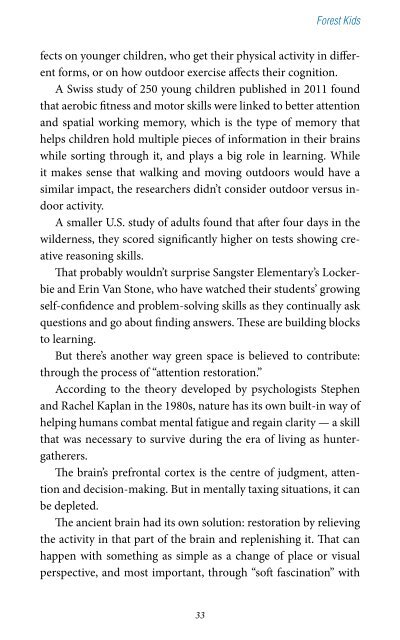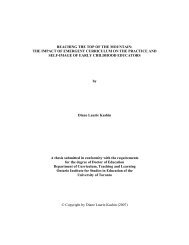Forest Kids
Create successful ePaper yourself
Turn your PDF publications into a flip-book with our unique Google optimized e-Paper software.
<strong>Forest</strong> <strong>Kids</strong><br />
fects on younger children, who get their physical activity in different<br />
forms, or on how outdoor exercise affects their cognition.<br />
A Swiss study of 250 young children published in 2011 found<br />
that aerobic fitness and motor skills were linked to better attention<br />
and spatial working memory, which is the type of memory that<br />
helps children hold multiple pieces of information in their brains<br />
while sorting through it, and plays a big role in learning. While<br />
it makes sense that walking and moving outdoors would have a<br />
similar impact, the researchers didn’t consider outdoor versus indoor<br />
activity.<br />
A smaller U.S. study of adults found that after four days in the<br />
wilderness, they scored significantly higher on tests showing creative<br />
reasoning skills.<br />
That probably wouldn’t surprise Sangster Elementary’s Lockerbie<br />
and Erin Van Stone, who have watched their students’ growing<br />
self-confidence and problem-solving skills as they continually ask<br />
questions and go about finding answers. These are building blocks<br />
to learning.<br />
But there’s another way green space is believed to contribute:<br />
through the process of “attention restoration.”<br />
According to the theory developed by psychologists Stephen<br />
and Rachel Kaplan in the 1980s, nature has its own built-in way of<br />
helping humans combat mental fatigue and regain clarity — a skill<br />
that was necessary to survive during the era of living as huntergatherers.<br />
The brain’s prefrontal cortex is the centre of judgment, attention<br />
and decision-making. But in mentally taxing situations, it can<br />
be depleted.<br />
The ancient brain had its own solution: restoration by relieving<br />
the activity in that part of the brain and replenishing it. That can<br />
happen with something as simple as a change of place or visual<br />
perspective, and most important, through “soft fascination” with<br />
33


















